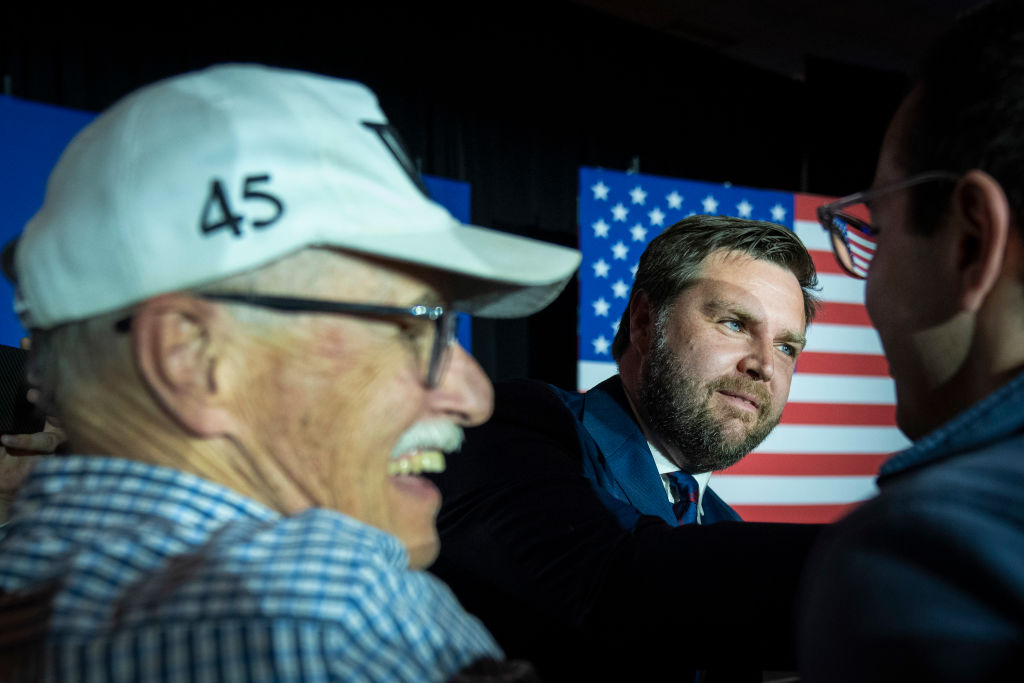
CINCINNATI, OH – MAY 3: Republican U.S. Senate candidate J.D. Vance reacts with supporters after winning the primary, at an election night event at Duke Energy Convention Center on May 3, 2022 in Cincinnati, Ohio. Vance, who was endorsed by former President Donald Trump, narrowly won over former state Treasurer Josh Mandel, according to published reports. (Photo by Drew Angerer/Getty Images)
The midterm season has officially begun, and with it, the results from yesterday’s, May 3 primaries for both Ohio and Indiana. While these races are often used as a gauge for party support prior to the November elections, this year’s ballot card offered somewhat more. Rightly or wrongly, the Fourth Estate is painting every vote cast as a referendum on former President Donald Trump’s power over American politics. With all 22 candidates backed by Trump winning their primaries, it seems apparent that 45 still holds a major role to play.
Ohio Senate
One of the most closely watched races was for the Senate seat soon to be vacated by retiring Republican Rob Portman in Ohio. Trump decisively won the Buckeye State in both 2016 and 2020, effectively ending its long-held reputation as a bellwether for presidential elections.
For the GOP nomination, a field of seven candidates fought it out in a contest that has garnered a huge amount of press attention. Winning handily was author J.D. Vance who took more than 32% of the vote in a crowded field – more than eight points ahead of his nearest rival Josh Mandel. What makes this particular win so significant is that until mid-April, Vance was a clear underdog polling an average of just ten percent. And then came Trump’s endorsement.
The legacy media has acted much like a desperate fortune teller, searching for any omen that would presage the waning of Trump’s political influence. The 20% boost from the coveted 45 nod will have analysts searching for fodder to dismiss Vance’s victory as an aberration, however, the fact that Mandel declared that his platform was “pro-God, guns, and Trump,” suggests that Ohio is still very much in favor of The Donald.
As J.D. Vance said during his victory speech, the media “wanted to write a story that this campaign would be the death of Donald Trump’s ‘America First’ agenda. Ladies and gentlemen, it ain’t the death of the ‘America First’ agenda.” All other contenders have now publically stated that they will be backing Vance for the Senate.

The Democratic Party primary was somewhat less eventful. Ohio US Representative Tim Ryan took the nomination with ease. With almost 20 years’ service in the House of Representatives and a short-lived 2020 presidential campaign, Ryan certainly had the name recognition to beat his two opponents. Gaining almost 70% of the votes, he will face Vance in November.
It is worth noting that Republican turnout was almost double that of Democrats.
Ohio Gubernatorial
Incumbent GOP Governor Mike DeWine received 48% of the primary votes, fending off three challengers. He has held a consistently high approval rating of between 18 and 26 points over the last three years and will be a tough opponent come November.
Facing this uphill battle will be Democrat primary winner and former Dayton Mayor Nan Whaley who took 65% of her party’s vote. Since 1991, only one Democrat has served as Ohio Governor, Ted Strickland, who lost after one term to Republican John Kasich.
Indiana Senate
Incumbent Republican Senator Todd Young ran uncontested as did Democrat contender, Thomas McDermott. Hopefuls to run against both men failed to make the ballot after being unable to secure the required 500 signatures in each of the state’s nine districts, perhaps indicating that each party’s voting base is content with the proposed slate.
In terms of funding, Young apparently has a war chest of more than $5 million compared to McDermott’s $1 million, which has granted the incumbent some breathing room. The GOP senator has so far not been endorsed by Donald Trump, which could cut down on his 10% victory margin from 2016.
McDermott’s last election campaign was for Northwest Indiana’s US House nomination in 2020 which he lost to now-Representative Frank Mrvan.
A Battle for Ideologies
This coming November will not be only a battle between Republicans and Democrats but also a struggle over the guiding ideology of each party. The GOP will face a decision on whether it backs Trump’s vision for America or for the traditional party politics. For Democrats, it seems that this contest is between the new progressive alliance and the Old Guard.
Either way, the national press will be engaged and fighting for its own vision via opinion articles and op-eds, attempting to craft stories that support its position and favored candidates. But when have facts ever gotten in the way of a good narrative?
Remember to check out the web’s best conservative news aggregator
Whatfinger.com — the #1 Alternative to the Drudge

